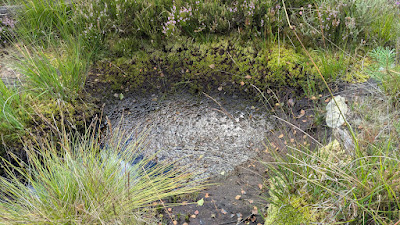Cropton is a Forestry England plantation in the North Yorkshire Moors, NW of Pickering. It is best known for hosting a family of Beavers since 2019, the result of a reintroduction trial in an enclosure which led to the first Beavers being born in Yorkshire in several hundred years. On first sight, Cropton forest might appear an unsuitable habitat to find Bog Bush-crickets. However, there are records, new and old, from Bog Bush-crickets in three afforested areas in Yorkshire: Cropton, Wykeham and Harwood, the more recently planted forests. Across the UK, Bog Bush-cricket appear to hold on to plantations, and small populations survive along rides and clear-felled areas which preserve the original wet heath vegetation (top shot, a naturally regenerating plot with recovering heath). There are three Bog Bush-cricket records, scattered across the forest in three different years: 2005, 2009 and 2012, so we included this forest in the recces for the project. We were encouraged to see that the records were present in or next to open areas and designed a 6 km route to explore the forest ans survey for any Bog Bush-crickets. As bog bush-crickets are now mostly adult, we used our acoustic monitoring device to find them.
One of the rides across the forest.
The wood was planted during the last century, mainly in the 1950s and 1960s. Lines and lines of conifers of the same age, growing close together creating a dark high wood. Progressively, and particularly in recent times, the management has become more biodiversity friendly, with removal of sections of dense woodland, thinning and allowing natural regeneration and increasing broad-leaf tree cover and also retaining low intervention plots for biodiversity benefits.
Small boggy pools with Sphagnum moss were dotted along the forest.
Blanket bog and heathland are UKBAP Priority Habitats. During our walk, it became obvious that there there are scattered patches of blanket bog and wooded heath covering clear felled areas or access tracks and rides. Deep peat areas will not be replanted, but are allowed to regenerate naturally. From the management plan:
'This plan will continue the management and development of heathland and wooded heath where this will improve habitat networks across Cropton forest. Maintaining a mixed resource of temporary and permanent open space with heathland flora will provide suitable habitat for Nightjar, Tree pipit, Woodcock and other priority species including Small pearl-bordered fritillary and large heath butterfly and adder.'
Today's was the last of the the recces. In future trips, we will carry out the acoustic surveys. We meet up with Clare and Matt, who are collecting water samples for a Beaver environmental impact project in the enclosure where the Beavers have been reintroduced, and get a lift with them. It is a mild day with a breeze and sunny spells, briefer than we would have liked.
We start the walk and we are accompanied by flurries of Peacock butterflies, looking very fresh. They feed on knapweeds and other flowers and bask on the ground.
This open area looked like it had good Bog Bush-cricket habitat. We heard several individuals and managed to locate a singing male, our first and only sighting of the day.
When overcast, conditions appear not suitable for calling bush-crickets, and they were silent. We were surprised to hear Roesel's from a ride with long tussocks of grass by a main ride. Later we spotted a long-winged male.
We identify possible transects for the acoustic survey and head towards the cafe, where we will meet Clare and Matt for lunch before heading back home.
More information
Cropton Forest Management Plan. Here.
















No comments:
Post a Comment